You are viewing 1 of your 1 free articles
Receiving and combining in crowded areas
| Area | Up to 40x40 yards |
| Equipment | Balls, bibs, cones, 4 small goals |
| No. of Players | Up to 24 players |
| Session Time | 2 hours |
This session is all about encouraging players to play with their heads up and to make the most of their opportunities to both pass and receive. It also encourages players to make the most of the available space to combine with team-mates and to play with their first touch into space when receiving a pass.
The session progresses from a passing and receiving practice to add combination play and playing forward. It then adds an element of competition, with two sets of teams playing against each other on the same pitch. The demands on the players to find the space to receive but then defend when the ball is lost is great because of the confusion caused by two games going on at the same time.
When goals are added to the practice, it takes on a new dimension by adding finishing rather than just getting the ball to a target player.
It is a return to the kind of football played in the school playground when, no matter how many games were being played, you always knew who you were playing with and against and never got involved in the wrong game.
Football coach Dick Bate once told me that a coaching session is not for those looking on but for those involved in it and that a practice does not have to be neat and tidy because at times football is scruffy.
Elements of this session can be built upon with follow up sessions where the principles learnt and the experiences of the players can be further developed.
“A coaching session is not for those looking on and does not have to be neat and tidy because, at times, football is scruffy”
PASSING AND RECEIVING
We set up a playing area of 30x30 yards. We’re using 24 outfield players split into four teams of six. Three players from each team are inside the playing area, each one with a ball. The other three players from each team are positioned around the outside of the playing area, alternating as shown.The players on the inside move around the area, finding a team mate on the outside to play the ball to. They receive it back before moving on to do the same with another of their team mates on the outside, as shown [1a].
[1a]
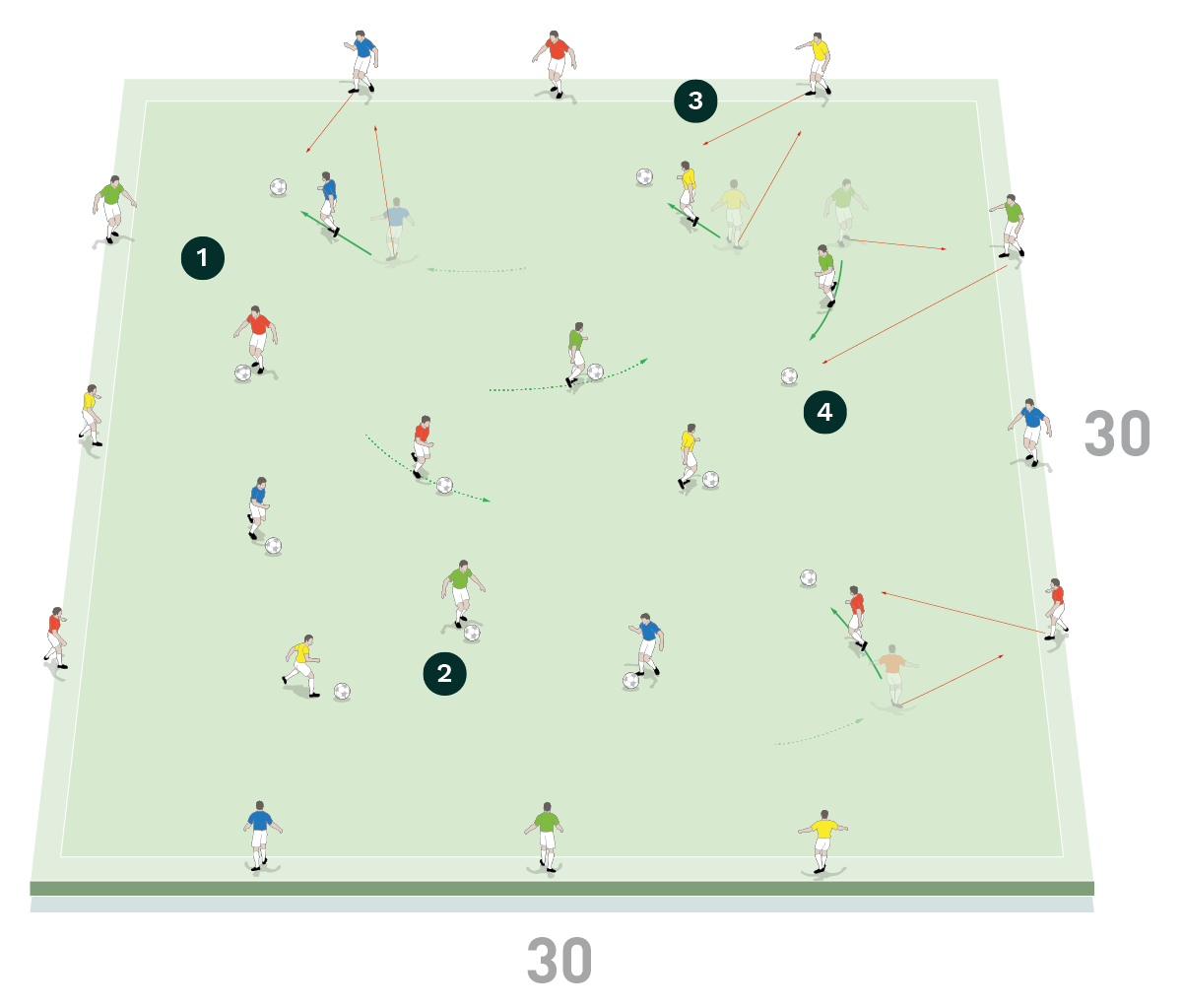
- Each team has three inside players and three on the outside of the playing area
- Each inside player has a ball. The players on the inside move around the playing area trying to find a team mate on the outside to play the ball to
- The outside player receives the ball and plays a return pass
- The inside player receives the ball back, before moving on to do the same passing and receiving move with another of their team mates on the outside
[1b]
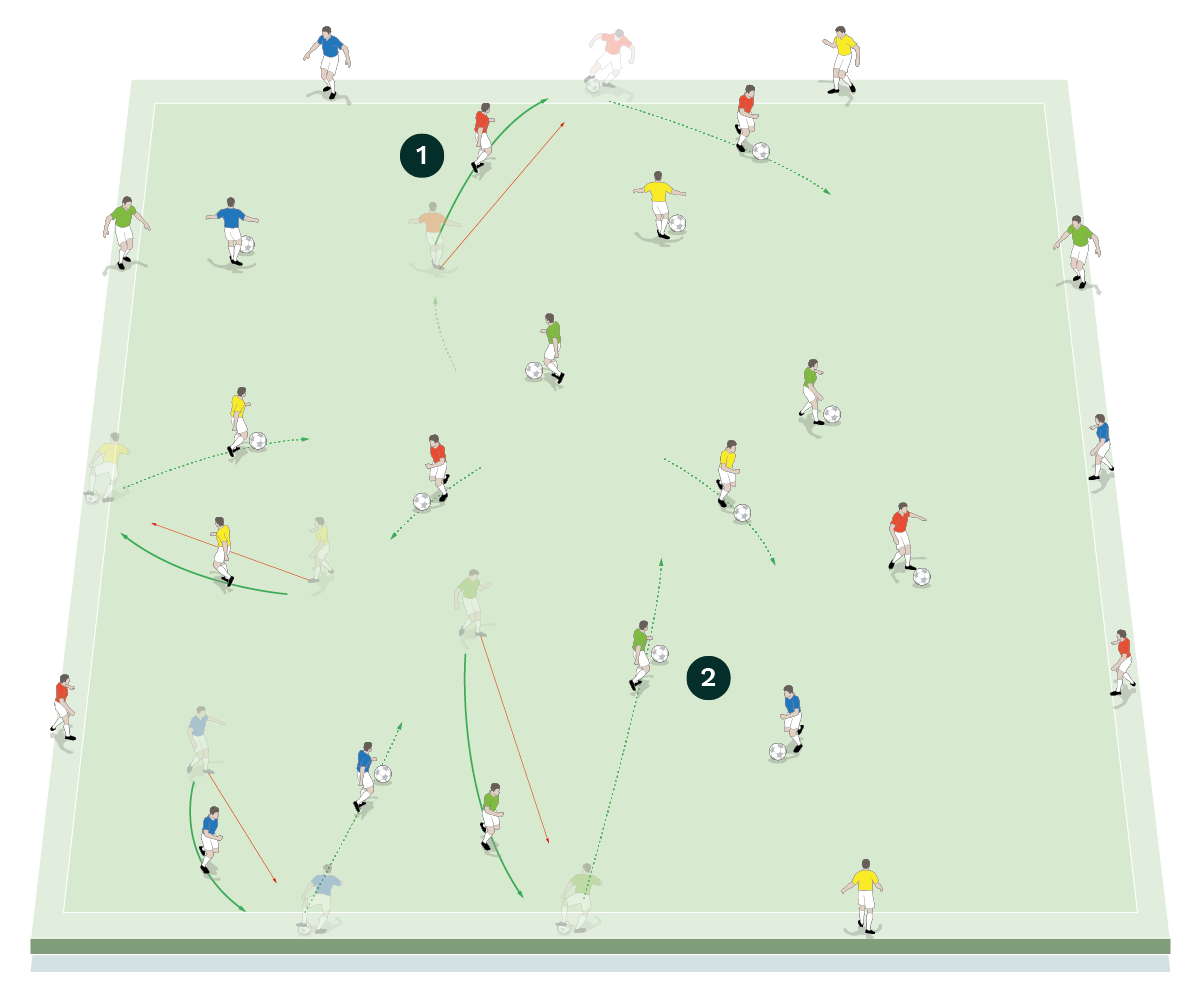
- As a progression, when an inside player passes to a team mate on the outside, they follow the ball and become the new outside player
- The original outside player now brings the ball into the playing area and dribbles around looking to find an outside team mate to pass to
“We want to see players on the inside showing where they want the return ball to be played and receiving with an open stance”
We want to see players on the inside showing where they want the return ball to be played and receiving with an open stance or receiving on the run. We also want to see players on the outside adjusting their body position to enable a first time pass to return the ball.
PROGRESSION 1
The size of the playing area is increased to 40x40 yards. Each team now has two outside players positioned on opposite sides or corners of the playing area, as shown. Each team has one ball and they must work the ball from one outside player to the other. When the pass is made to the outside player at the end of the move, the receiving player dribbles the ball back into the centre of the playing area and swaps roles with the inside player who passed the ball, as shown [2].[2]
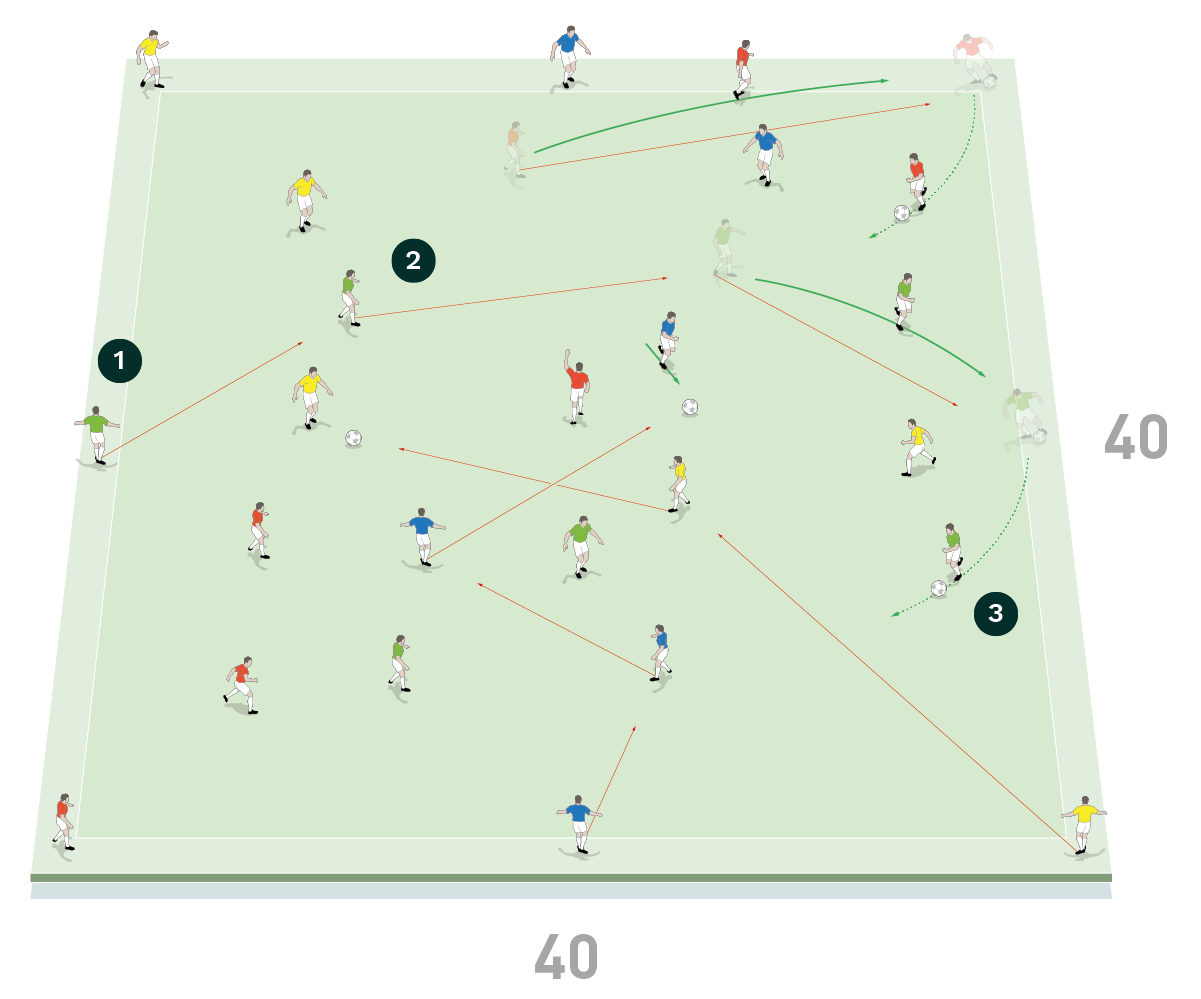
- Each team now has two outside players positioned on opposite sides or corners of the playing area.
- Each team has one ball and they must work the ball from one outside player to the other, passing via the inside players
- When the pass is made to the outside player at the end of the move, the receiving player dribbles into the area and swaps roles with the passer
The fact that four balls and four teams are moving at the same time in a congested area adds to the difficulty.
PROGRESSION 2
This time, each side of the playing area is split in half and the blue team plays against the red team from top to bottom, while the green team plays against the yellow team from left to right. Each team has four players in the middle of the playing area and two positioned on the outside, as shown [3].[3]
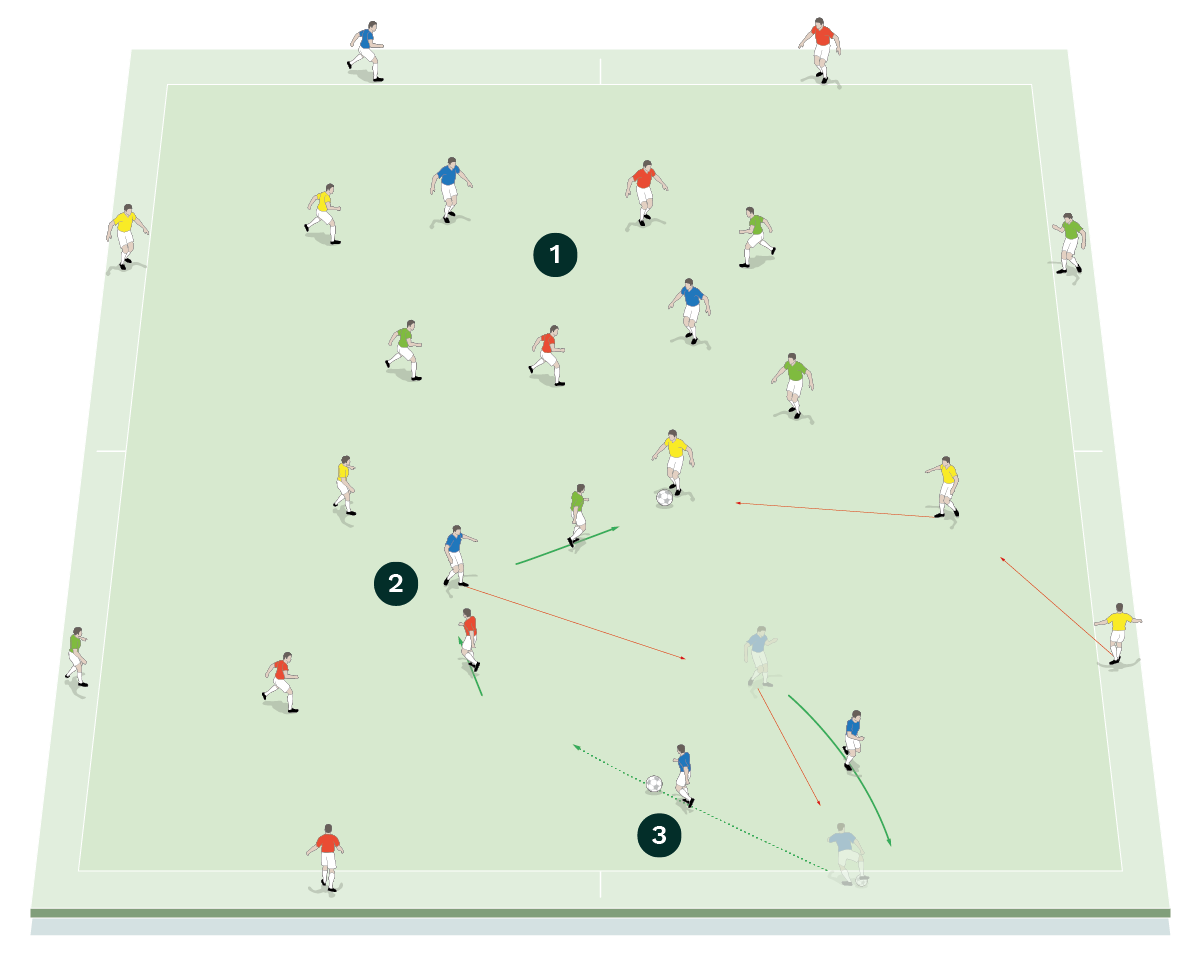
- Each team has four players in the middle and two positioned on the outside. The blue team plays against the red team from top to bottom. The green team plays against the yellow team from left to right
- In each duel, one team starts with the ball and they work it from one outside player to the other, without losing possession to their opponents, who press to win the ball
- If they succeed in transferring the ball, after playing the pass to the outside player the passer must swap places and roles with the outside player and play continues
If a player cannot go forward with the ball, they can always pass it back to the starting outside player and begin the build up again.
We want to see players playing with their heads up so they’re aware of what and who is around them, meaning they can receive the ball away from their opponents and pass to a player away from where the pressure is coming from.
PROGRESSION 3
To progress the session further, small goals are placed on each corner and each team now has one goal to defend and one to attack.The players are now split into four teams of six including goalkeepers. Two teams play against each other from corner to the diagonally opposite corner, trying to pass and move to create goal scoring opportunities. The other two teams play a simultaneous game between the other two diagonally opposite corners. Each game starts and restarts with a pass out from a keeper, as shown [4].
[4]
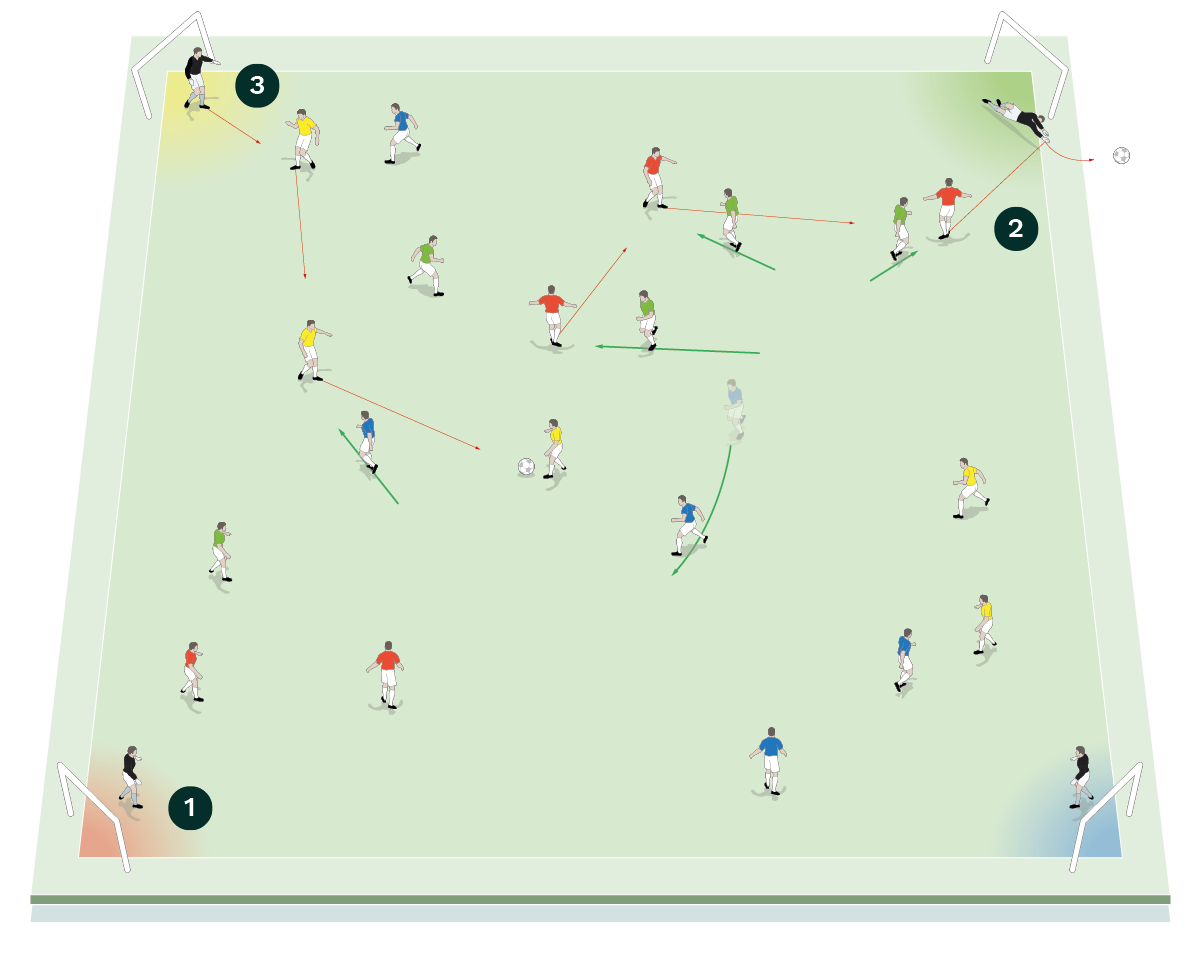
- Small goals are placed on each corner and each team now has one goal to defend and one to attack
- Two teams play against each other from corner to diagonally opposite corner, trying to pass and move to create goal scoring opportunities. Here the reds take on the greens
- The other two teams play a simultaneous game between the other two diagonally opposite goals. Each game starts and restarts with a pass out from the a keeper. Here the yellows take on the blues
When defending, we want to see players recovering back into central areas to defend the goal.
PROGRESSION 4
To progress the session further, we remove two goals and now only one 6v6 game takes place at a time. One team defends one goal and attacks the other diagonally opposite goal and the other team plays in the opposite direction from goal to goal, as shown [5].[5]
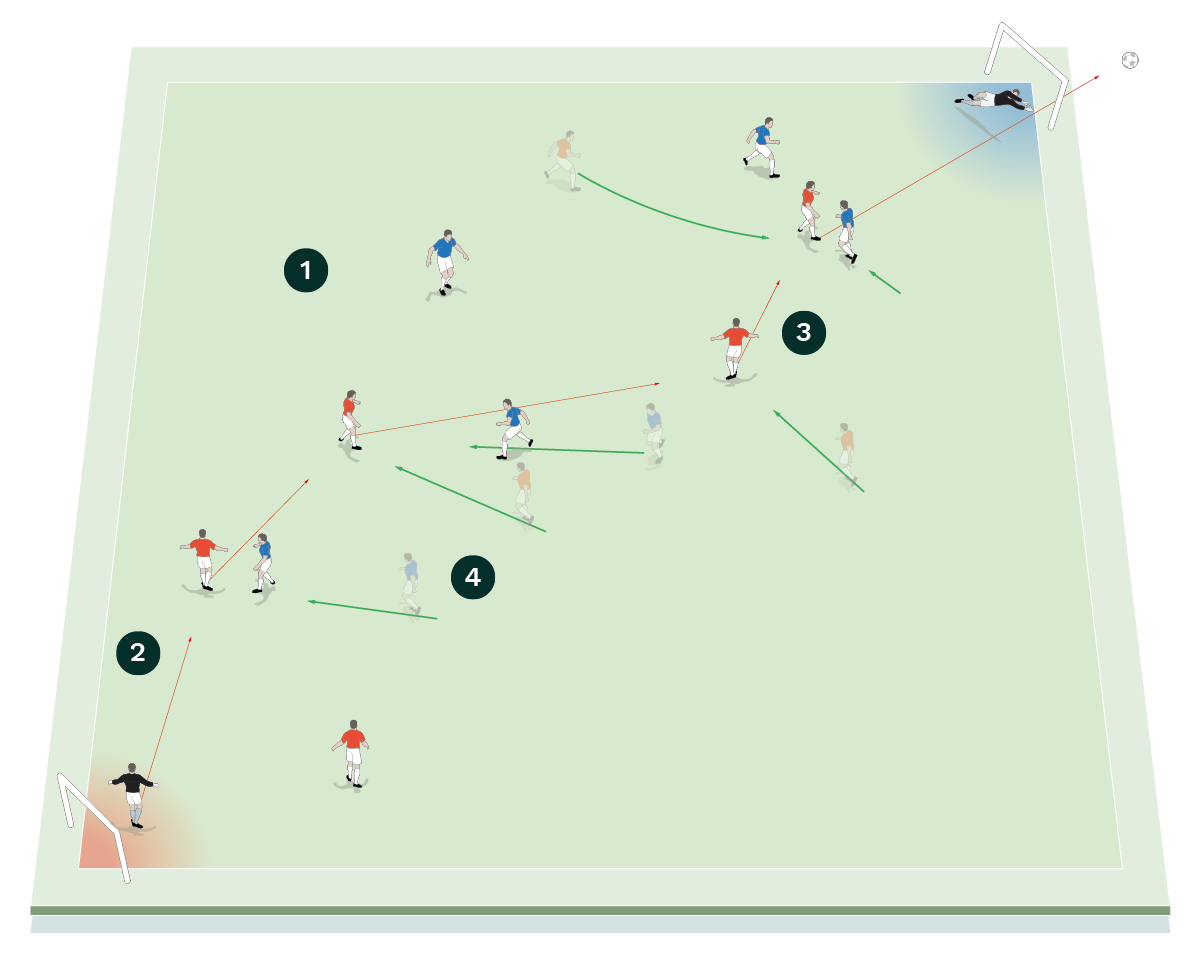
- Only two teams of six play. Each team has one goal to defend and one to attack
- The goalkeeper should start and restart play by distributing wide or to a central midfield player
- The possession team should build up play and try to score in the goal they are attacking
- When out of possession teams should defend centrally to limit space for the opposition to attack and defending should begin from the front player
COACHING POINTS
What are the key things to look out for?All the way through the practice players have to play with their heads up, not only to see opportunities to receive and pass the ball but also to be aware of where opposing players are.
Tactically, we want to see players using the space available and when in possession they should spread out to use the full area. The choice of pass and where to play the ball for a player to receive on the move going forward can also be worked on throughout the practice. Add this to supporting forward play and ball retention and you can then see how much can be worked on in the session.
Defensively, pressure on the ball and restricting space can be elements that can be emphasised, as can recovery movements back to defend when the ball is lost.
What are the typical mistakes players might make and how do I avoid them?
Players sometimes fail to be aware of what is on for them when they receive the ball, meaning that they either turn into pressure or do not relieve pressure on their first touch. Also, when going forward the ball needs to be played in front of a player to allow momentum and thus players need to time a run well to receive a ball in their stride.
Related Files
Editor's Picks
Using the goalkeeper in build-up play
Pressing principles
Intensive boxes drill with goals
Penetrating the final third
Creating and finishing
My philosophy
Pressing initiation
Compact team movement
Defensive organisation
Coaches' Testimonials

Alan Pardew

Arsène Wenger

Brendan Rodgers

Carlos Carvalhal

José Mourinho

Jürgen Klopp

Pep Guardiola

Roy Hodgson

Sir Alex Ferguson

Steven Gerrard
Coaches' Testimonials

Gerald Kearney, Downtown Las Vegas Soccer Club

Paul Butler, Florida, USA

Rick Shields, Springboro, USA

Tony Green, Pierrefonds Titans, Quebec, Canada
Join the world's leading coaches and managers and discover for yourself one of the best kept secrets in coaching. No other training tool on the planet is written or read by the calibre of names you’ll find in Elite Soccer.
In a recent survey 92% of subscribers said Elite Soccer makes them more confident, 89% said it makes them a more effective coach and 91% said it makes them more inspired.
Get Monthly Inspiration
All the latest techniques and approaches
Since 2010 Elite Soccer has given subscribers exclusive insight into the training ground practices of the world’s best coaches. Published in partnership with the League Managers Association we have unparalleled access to the leading lights in the English leagues, as well as a host of international managers.
Elite Soccer exclusively features sessions written by the coaches themselves. There are no observed sessions and no sessions “in the style of”, just first-hand advice delivered direct to you from the coach.









